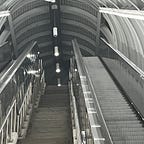Spike in gas prices highlights issues in the public transportation system.
By Humberto Mendez Prince
The recent economic setback affecting the country the last few months has slid its way down an already dwindling transportation system, the increase in gas prices has seen taxpayers flock to public transit, and without a choice be at the mercy of traffic jams, unfinished roadwork, and unmodernized equipment.
With every major economic crisis there's a natural increase in public transport usage, in 2010 just two years after the great financial crisis, the people that chose to commute in public transport decided to do so mainly on buses and subways, neglecting other free alternatives.
The same occurred during the pandemic two years ago, although gas prices were considerably low in comparison with nowadays and many people opted out of public transportation due to health concerns, still a high percentage of public transit users preferred to pay for these services rather than free transportation such as trollies.
Part of the public concern during this period came due to low-cost solutions to disproportionate problems. For example, public transport services across the country dialed down on spending on their services, so many of the already faulty equipment and roofless stops retained their damaged condition due to cost-effective solutions.
However, there's a reason as to why oftentimes people steer clear from using free trolley systems and instead decide to pay for other equally malfunctioning public transportation, and it all boils down to waiting time and comfortability. For example, trolley services in Miami are often criticized by users for their rigid seats and noisy engines, prompting many of them to choose more comfortable and ear-friendly alternatives offered by the city.
This doesn't mean that other alternatives are the best option, in fact, waiting times in Miami are among the highest in the major cities of the world, Madrid, Munich, and Montreal stand out as being among the cities with less waiting time for their users using public transit. At the same time, Miami, New York, and Washington D.C emerge as being the cities with the most waiting time for their users.
On the other hand, the U.S's major concern regarding transportation is highlighted in the latest oil and gas prices, the abrupt reinstallation of the Taliban in Afghanistan, and the geopolitical conflict between Ukraine and Russia has put the American economy in a chokehold. And as a consequence, the result of these conflicts can be reflected in national gas prices, more specifically, states such as Florida and California have been the most affected by the transnational conflicts.
Experts argue that inflation will start to ease at the beginning of next year, stating that the American economy has been teetering in the past two years due to the pandemic, so we can expect in turn that oil and gas prices are dependent on the outcome of recent international affairs.
And until gas and oil prices don't stabilize, taxpayers cannot expect much improvement in public transport. Last month, President Biden confirmed, “A large contributor to inflation this month was an increase in gas and energy prices as markets reacted to Putin’s aggressive actions.”
